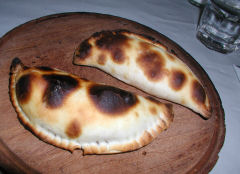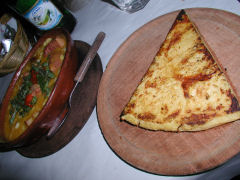Buenos Aires – One of the major local papers, La Nacion, in their weekly magazine supplement, just had an interesting food section that focused on Asian cuisine. I tend to be a big fan of a lot of Asian cuisine, so this was of particular interest. You know, Chinese food wouldn’t exist if it wasn’t for the Jewish people…
A Chinese man and a Jewish man are talking. The Chinese man says, “I understand that it’s the year 5766 in your calendar?”
The Jewish man replies, “Yes, that’s right.”
“Well, in the Chinese calendar, it’s only 4702. What did your people do for food for the first thousand years?”
Probably only funny to other Jewish folk…
I’m not going to translate the whole section, as it goes on for pages, but here’s a rough translation of the important parts of the introduction:
“Food from the far east has invaded the western world. Woks and chopsticks are part of daily life. Asian food can be divided into four groups – Chinese, Japanese, Korean, and Other. The main group is Chinese, which influenced all the others. Chinese cooking is elaborate, flavorful, and generally oily. North Americans (U.S.A.) love it and are addicted to having it delivered to their homes, and will try anything, like fried eel and shark fin soup. Chinese food doesn’t begin with eggrolls and end with sweet and sour chicken, in fact, the Chinese will eat any part of an animal except the mouth and rectum, considering everything else edible. In contrast, Japanese food is delicately flavored and elegant. They eat a lot of fish, love plums as digestifs, and rice infused with green tea. Internationally, they are most famous for sushi (white rice wrapped in seaweed and stuffed with different fillings) and sashimi (slices of raw fish), especially the highly poisonous fugu. Korean food is the least well known, but once tried, there’s no going back – if you like very spicy food – bul gogi (slices of roasted meat) and kim chi (spicy cabbage) are high ranking examples. Korean food, unlike Japanese and Chinese, conforms to the style of a main plate accompanied by various side dishes (sprouts, seaweed, and tofu), and is always eaten with metal chopsticks. Among the less famous cuisines is Vietnamese, which is very aromatic and uses a lot of cilantro, peanuts, and coconut; Thai, which is very strong and spicy; Indian, extremely spicy; and Filipino, which is just like Chinese.”
How’s that for an over-generalization, not to mention stuff that’s just plain wrong? No wonder folks here are suspicious of Asian cuisine!
They then go on to give various recommendations for typical dishes – respectively, Chinese – eggrolls, Japanese – sushi, Korean – barbecue, and Vietnamese – springrolls (raw and fried). After that, their recommendations for the best places in town to try each type of food.
Following that is a breakdown by neighborhood of their recommendations for various other types of restaurants, which brings me to yesterday. I was out searching for some specialty paper for my printer (anything other than plain white, copy grade paper seems quite difficult to find), and decided to stop in at one of La Nacion’s top recommendations for Argentine regional cuisine. I was hoping that they were probably more on target with their own native food.
 Luckily, they were! Cumaná, Rodriquez Peña 1149, in Recoleta, is a real keeper. Cumaná is a state in Venezuela, so perhaps despite La Nacion’s claim, the food is more typical of that region. I did note that although the listing of the dishes included a lot I’ve seen before, there were some others I wasn’t familiar with, and the things I tried were different from others here. First off, I like the style of the place – rustic, with antique cooking implements and ristras of garlic hanging from the walls. Full sized paper napkins on the table (instead of the usual miniature plasticized, non-absorbent excuses for napkins), a bustling vibe, and good looking, friendly staff. They offer a sort of “high tea” in the afternoons, but with maté and sponge cookies with marmalade, rather than Earl Grey and crumpets, or what have you. I started off with a couple of empanadas, of course. The lomo picante was superb, with a filling of simple diced sirloin and plenty of spices; and another excellent choice that was a blend of corn and pumpkin, the first time I’ve seen that. They were baked, in a wood-burning oven (which dominates one end of the room), and the little extra charring from that made these among the better empanadas I’ve had.
Luckily, they were! Cumaná, Rodriquez Peña 1149, in Recoleta, is a real keeper. Cumaná is a state in Venezuela, so perhaps despite La Nacion’s claim, the food is more typical of that region. I did note that although the listing of the dishes included a lot I’ve seen before, there were some others I wasn’t familiar with, and the things I tried were different from others here. First off, I like the style of the place – rustic, with antique cooking implements and ristras of garlic hanging from the walls. Full sized paper napkins on the table (instead of the usual miniature plasticized, non-absorbent excuses for napkins), a bustling vibe, and good looking, friendly staff. They offer a sort of “high tea” in the afternoons, but with maté and sponge cookies with marmalade, rather than Earl Grey and crumpets, or what have you. I started off with a couple of empanadas, of course. The lomo picante was superb, with a filling of simple diced sirloin and plenty of spices; and another excellent choice that was a blend of corn and pumpkin, the first time I’ve seen that. They were baked, in a wood-burning oven (which dominates one end of the room), and the little extra charring from that made these among the better empanadas I’ve had.
 Even more interesting was the locro, the ubiquitous corn and pumpkin based stew of the Andes. Hands down this is the best locro I’ve had in Buenos Aires (including my own, found at the link above). It was chockful of hominy and lima beans, a variety of different sausages, bacon, and roasted beef and topped with a thick tomato-green onion salsa that was spicy and delicious; and the whole dish was spiked with a touch of vinegar that added a whole new dimension to it. I ordered a side of fainá, a thick, chickpea flour pancake that is served in wedges. This could have used a touch of salt, but that was easy enough to rectify. All around – yum! I wish I’d had enough room to try some of the dessert empanadas, something I don’t often see, that included a version filled with chayote squash, one of my favorite vegetables. Oh wait… they deliver… and after all, we North Americans are addicted to delivery… (This from a newspaper in a culture where anything and everything can be and is delivered!)
Even more interesting was the locro, the ubiquitous corn and pumpkin based stew of the Andes. Hands down this is the best locro I’ve had in Buenos Aires (including my own, found at the link above). It was chockful of hominy and lima beans, a variety of different sausages, bacon, and roasted beef and topped with a thick tomato-green onion salsa that was spicy and delicious; and the whole dish was spiked with a touch of vinegar that added a whole new dimension to it. I ordered a side of fainá, a thick, chickpea flour pancake that is served in wedges. This could have used a touch of salt, but that was easy enough to rectify. All around – yum! I wish I’d had enough room to try some of the dessert empanadas, something I don’t often see, that included a version filled with chayote squash, one of my favorite vegetables. Oh wait… they deliver… and after all, we North Americans are addicted to delivery… (This from a newspaper in a culture where anything and everything can be and is delivered!)
[…] However, La Cholita here is a moderately pricey, decent quality parrilla, or steakhouse. The food is entirely Argentine, and local style – no “regional” dishes are offered, no peasant food. Just grilled steaks, innards, and chicken, along with the usual range of salads and appetizers. In fact, other than a few cold dishes like salads, everything at this locale comes directly off the grill – todo a la parrilla is stated right on the windows of the restaurant and on the menu. Visually, the place is a virtual twin of its next door neighbor, Cumaná, which I’ve reviewed before (and which has all those peasant, regional dishes), long, narrow, heavy wooden tables and wicker chairs, white paper on each tabletop, and even the same basket of crayons. The open kitchen at the back could be a mirror image. The lighting is so dim as to make it near impossible to read a menu – 99% of the lighting comes from a small tea candle on each table, the balance comes from extraordinarily dim bulbs hanging high above (10 watt maybe?) and a touch from the grill area at the back. There’s no air in the place – it was stiflingly hot, without air conditioning or ceiling fans, and with no rear opening, no airflow even with the door propped open at the front, and everything gets heated from the kitchen and the candles. There’s a second, upstairs dining area as well, that unfortunately requires you pass by the bathrooms at the top of the stairs, which, bluntly, stink. […]
[…] also an immediate assumption, for the most part without having tried the food, that “Asian food is very spicy“. It’s even more notable that the non-Argentines in the class whom I’ve had a […]
[…] Cumana also offers up many other great regional dishes from around the rest of Argentina and Latin America. Their Locro, Mondongo and Tamales are all very tasty. In fact, in addition to enjoying the same empanada fillings at Cumana, Saltshaker also speaks very highly of their Locro. […]
[…] Asian cooking one weekend, that I did my best to translate in my rudimentary Spanish at the time, here. It’s worth a read, if for nothing other than face […]
[…] stop by an old favorite, Cumaná, Rodriguez Peña 1149 here in Recoleta, with a winemaker friend who was passing through on […]
[…] Cumaná also offers up many other great regional dishes from around the rest of Argentina and Latin America. Their Locro, Mondongo and Tamales are all very tasty. In fact, in addition to enjoying the same empanada fillings at Cumana, Saltshaker also speaks very highly of their Locro. […]